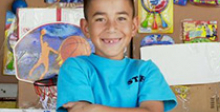Internal mini form
Contact Us Today
With classrooms mainstreaming children with special needs into traditional classrooms, students need more encouragement than ever before to participate in educational and social activities.
Ten tips for teachers
Educators are unsung heroes in our society. They make sure young people are armed with the information they need to become productive adults. They continue to move students progressively upward. In the best of scenarios, educators teach children everything they need to know about history, science, math and English. They also inspire children to dig deep within themselves to become well-rounded individuals and become sensitive to the needs of others.
Too often, teachers have been forced to be all things to all people. In the case of teachers that have children with special needs in their classrooms, there is another task: To encourage a child that has a disability to participate in the learning environment even if they communicate differently, or complete assignments in an alternative fashion.
Participation leads to acceptance for students with special needs because it helps them show that they can function with the classroom environment. It allows them to show others they are capable of understanding class lessons, and that they are capable of forming relationships. It helps the child take a step away from dependency, and it helps them grow into exceptional, socially-adjusted adults. It also minimizes negative peer interactions in and outside of the classroom.
Here are 10 ways a teacher can encourage acceptance of special needs students.
1. Understand the nature of a child’s disability.
Teachers play an important role in helping a child develop positive self-esteem. Self-confidence is among a child’s chief concerns, especially if he or she has special needs. Part of making sure a child develops a healthy self-image, and learns in the classroom is to understand how a child’s disabilities affect their ability to learn. If a child communicates using a speech-generation device, will they be able to respond in a timely fashion in class? If they use a wheelchair, how can they participate in physical education, recess, class presentations, and laboratory exercises? Once an educator understands a child’s abilities and challenges, he or she will have a better idea about how to proceed with lesson plans.
2. Teach from a compassionate point of view.
When a teacher is considering a classroom project that is more complex than a straightforward lecture or test, consider how a child with special needs will complete the assignment. A child with disabilities is already concerned about standing out – it’s a time in life when children prefer to fit in. If completing the project means a child with special needs will have to go about it in a way that draws too much attention from classmates, perhaps it is best to reconsider the assignment for the entire class. In many cases, special needs children don’t need the bar lowered for their benefit. But they also don’t want the requirements to be so vastly different from the way other students satisfy the assignment that it attracts unwanted attention.
3. Make sure students are showing sensitivity.
Studies show that children with special needs are bullied more often than other students, and it should not be tolerated. Today, with bullying prevention being in the forefront of school activities, new programs to encourage kindness among children are becoming the norm. But often, situations will occur between students. If these occur, take the students aside to find out what the issue is. Explain why bullying is wrong, and why a student’s attitude needs to change. And if a warning doesn’t work, don’t be afraid to speak to a student’s parents to ensure a classroom is a safe, educational and fun environment for all young people.
4. Call on a special needs student during lectures.
This one may seem simple, but students with disabilities want to participate in class. If they use alternative or assistive devices to communicate, allow them to use it to answer questions. Call on students when they volunteer to answer a question, or even when they don’t.
It might be best to meet with a student’s paraprofessional or aide, or his or her parents, so a teacher can find out more about how a child can participate in class. This way, a teacher can adequately plan for a student’s input.
5. Find ways similar paths for physical participation.
Children with physical difficulties often have trouble taking part in activities. Teachers that instruct classes that require physical participation, such as Gym or Music, should identify ways for a student with special needs to participate. It’s not acceptable for a gym teacher to make a student with disabilities a team manager; they want to play the game. If students are playing baseball, let a student wheel around the bases, or if there is the possibility of obtaining adaptive equipment, an educator should look into it.
6. Give children all of the information they need about a classmate’s disability.
Part of the reason special needs children feel isolated is that for other children, there’s an air of mystery that surrounds disability. Educators should explain to children that a special needs student may move differently than they do. Or, they may speak differently than they do. However, they have interests that are similar to other children, and in many cases, they have a lot in common with their peers. Start a dialog with students. Answer all of their questions about what a student can, or cannot do. Let them know that students with special needs understand everything they say to them, so it’s okay if they want to talk to the student. Let the students know that if they’re gentle, they can touch and play with the student. If a teacher feels a guest speaker with a disability would be more helpful, invite someone to the school. Creating an atmosphere where everyone is comfortable is helpful to all students.
7. Discuss the importance of diversity and social acceptance.
Until children go to school, they often live in a vacuum. The people at home are most often similar to themselves, and new people that are different may seem peculiar. An educator can help students see that there are all different sorts of people in the world, and everyone has something to contribute. Give students examples of people that have disabilities that have contributed something unique to the world. This way, they’ll see being different is valuable.
8. Debunk the meaning of “normal.”
Each person has their own definition of what’s normal. People with disabilities have a certain number of tasks they complete during the day, and certain ways they accomplish goals. Teachers can explain that this is as normal to the student with special needs as another student’s daily routine is to his or herself.
9. Ask a child – any child – if you can help them out.
If a child seems to be having a difficult time reaching out or participating, ask them directly how a teacher can help. If that means breaking the ice between a student with special needs and his or her classmates, then why not schedule some group assignments so students can get to know each other better?
10. Address stereotypes.
Negative perceptions can be irritatingly difficult to break. But children, more than adults, have the capacity to change course and take a more positive road. All children – not only those with disabilities – need to know that they are unique. All young people have aspects to them that others may not consider; people don’t fit into the mold that stereotypes too often perpetuate. Teachers are role models that have the ability to help children move past stereotypes, and at every turn, it helps children learn to love themselves and others is they understand that everyone is different.

Acceptance
When a child with a disability reaches adulthood, feelings about acceptance by others may linger. If young people learn to accept themselves during their formative years, explore interests, form friendships, accomplish, interact, and socialize at age-appropriate stages, it can help empower a sense of belonging when they’ve grown.
Learn more
- About Acceptance
- Acceptance: Tips for Individuals with Cerebral Palsy
- Acceptance: Tips for Parents
- Acceptance: Tips for Teachers
- Inclusion
For more helpful tips, visit
Managing Cerebral Palsy and
Maximizing Potential.








